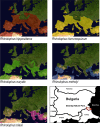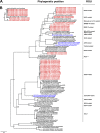Genomic characterization of severe acute respiratory syndrome-related coronavirus in European bats and classification of coronaviruses based on partial RNA-dependent RNA polymerase gene sequences
- PMID: 20686038
- PMCID: PMC2953168
- DOI: 10.1128/JVI.00650-10
Genomic characterization of severe acute respiratory syndrome-related coronavirus in European bats and classification of coronaviruses based on partial RNA-dependent RNA polymerase gene sequences
Abstract
Bats may host emerging viruses, including coronaviruses (CoV). We conducted an evaluation of CoV in rhinolophid and vespertilionid bat species common in Europe. Rhinolophids carried severe acute respiratory syndrome (SARS)-related CoV at high frequencies and concentrations (26% of animals are positive; up to 2.4×10(8) copies per gram of feces), as well as two Alphacoronavirus clades, one novel and one related to the HKU2 clade. All three clades present in Miniopterus bats in China (HKU7, HKU8, and 1A related) were also present in European Miniopterus bats. An additional novel Alphacoronavirus clade (bat CoV [BtCoV]/BNM98-30) was detected in Nyctalus leisleri. A CoV grouping criterion was developed by comparing amino acid identities across an 816-bp fragment of the RNA-dependent RNA polymerases (RdRp) of all accepted mammalian CoV species (RdRp-based grouping units [RGU]). Criteria for defining separate RGU in mammalian CoV were a >4.8% amino acid distance for alphacoronaviruses and a >6.3% distance for betacoronaviruses. All the above-mentioned novel clades represented independent RGU. Strict associations between CoV RGU and host bat genera were confirmed for six independent RGU represented simultaneously in China and Europe. A SARS-related virus (BtCoV/BM48-31/Bulgaria/2008) from a Rhinolophus blasii (Rhi bla) bat was fully sequenced. It is predicted that proteins 3b and 6 were highly divergent from those proteins in all known SARS-related CoV. Open reading frame 8 (ORF8) was surprisingly absent. Surface expression of spike and staining with sera of SARS survivors suggested low antigenic overlap with SARS CoV. However, the receptor binding domain of SARS CoV showed higher similarity with that of BtCoV/BM48-31/Bulgaria/2008 than with that of any Chinese bat-borne CoV. Critical spike domains 472 and 487 were identical and similar, respectively. This study underlines the importance of assessments of the zoonotic potential of widely distributed bat-borne CoV.
Figures






References
-
- Becker, M. M., R. L. Graham, E. F. Donaldson, B. Rockx, A. C. Sims, T. Sheahan, R. J. Pickles, D. Corti, R. E. Johnston, R. S. Baric, and M. R. Denison. 2008. Synthetic recombinant bat SARS-like coronavirus is infectious in cultured cells and in mice. Proc. Natl. Acad. Sci. U. S. A. 105:19944-19949. - PMC - PubMed
-
- Benda, P., T. Ivanova, I. Horáček, V. Hanák, J. Červený, J. Gaisler, A. Gueorguieva, B. Petrov, and V. Vohralík. 2003. Bats (Mammalia: Chiroptera) of the eastern Mediterranean. Part 3. Review of bat distribution in Bulgaria. Acta Soc. Zool. Bohem. 67:245-357.
-
- Cavanagh, D. 1997. Nidovirales: a new order comprising Coronaviridae and Arteriviridae. Arch. Virol. 142:629-633. - PubMed
-
- Chinese Sars Molecular Epidemiology Consortium. 2004. Molecular evolution of the SARS coronavirus during the course of the SARS epidemic in China. Science 303:1666-1669. - PubMed
Publication types
MeSH terms
Substances
LinkOut - more resources
Full Text Sources
Other Literature Sources
Research Materials
Miscellaneous

